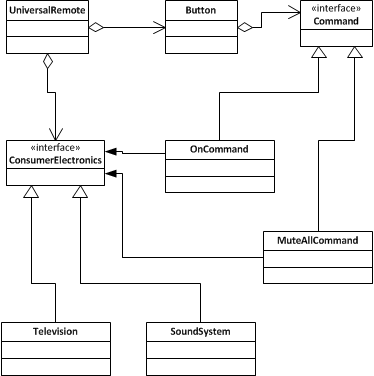设计模式14 - 命令模式 Command Pattern
来源:互联网 发布:python最突出的优点 编辑:程序博客网 时间:2024/05/22 14:59
Command design pattern is used to encapsulate a request as an object and pass to an invoker, wherein the invoker does not knows how to service the request but uses the encapsulated command to perform an action.
To understand command design pattern we should understand the associated key terms like client, command, command implementation, invoker, receiver.
- Command is an interface with execute method. It is the core of contract.
- A client creates an instance of a command implementation and associates it with a receiver.
- An invoker instructs the command to perform an action.
- A Command implementation’s instance creates a binding between the receiver and an action.
- Receiver is the object that knows the actual steps to perform the action.
Command Pattern Discussion
It will be easier to understand all the above with an example. Let us think of developing a universal remote. Our UnversalRemote will have only two buttons, one is to power on and another is to mute all associated ConsumerElectronics.
For ConsumerElectronics we will have couple of implementations Television and SoundSystem. Button is a class that is the invoker of an action.
OnCommand is used to switch on a ConsumerElectronics. While instantaiting OnCommand client needs to set the receiver. Here receiver is either Television or SoundSystem. UniversalRemote class will maintain all the receivers and will provide a method to identify the currently active receiver.
When an instance of a invoker is created, a concrete command is passed to it. Invoker does not know how to perform an action. All it does is honoring the agreement with the Command. Invoker calls the execute() method of the set concrete command.
UML Diagram for Command Pattern

Command Pattern Example Implementation
Command.java
public interface Command { void execute(); }OnCommand.java
public class OnCommand implements Command { private ConsumerElectronics ce; public OnCommand(ConsumerElectronics ce) { this.ce = ce; } public void execute() { ce.on(); }}MuteAllCommand.java
import java.util.List;public class MuteAllCommand implements Command { List<ConsumerElectronics> ceList; public MuteAllCommand(List<ConsumerElectronics> ceList) { this.ceList = ceList; } public void execute() { for (ConsumerElectronics ce : ceList) { ce.mute(); } }}ConsumerElectronics.java
public interface ConsumerElectronics { void on(); void mute(); }Television.java
public class Television implements ConsumerElectronics { public void on() { System.out.println("Television is on!"); } public void mute() { System.out.println("Television is muted!"); }}SoundSystem.java
public class SoundSystem implements ConsumerElectronics { public void on() { System.out.println("Sound system is on!"); } public void mute() { System.out.println("Sound system is muted!"); }}Button.java
public class Button { private Command c; public Button(Command c) { this.c = c; } public void click() { c.execute(); }}UniversalRemote.java
public class UniversalRemote { public static ConsumerElectronics getActiveDevice() { // Here we will have a complex electronic circular :-) // that will maintain current device Television tv = new Television(); return tv; }}DemoCommandPattern.java
import java.util.List;import java.util.ArrayList;public class DemoCommandPattern { public static void main(String[] args) { // OnCommand is instantiated based active device supplied by Remote ConsumerElectronics ce = UniversalRemote.getActiveDevice(); OnCommand onCommand = new OnCommand(ce); // Create an instance of a command implementation Button onButton = new Button(onCommand); onButton.click(); Television tv = new Television(); SoundSystem ss = new SoundSystem(); List<ConsumerElectronics> all = new ArrayList<ConsumerElectronics>(); all.add(tv); all.add(ss); MuteAllCommand muteAll = new MuteAllCommand(all); Button muteAllButton = new Button(muteAll); muteAllButton.click(); }}Output:

Important Points on Command Pattern
- Command pattern helps to decouple the invoker and the receiver. Receiver is the one which knows how to perform an action.
- Command helps to implement call back in java.
- Helps in terms of extensibility as we can add new command without changing existing code.
- Command defines the binding between receiver and action.
- A command should be able to implement undo and redo operations. That is restting the state of the receiver. It can be done from the support of receiver.
- 设计模式14 - 命令模式 Command Pattern
- 命令设计模式(Command Pattern)
- 设计模式 - Command Pattern(命令模式)
- 设计模式 - Command Pattern(命令模式)
- 设计模式之命令模式(Command Pattern)
- c++设计模式:命令模式(Command Pattern)
- 设计模式 - 命令模式(command pattern) 详解
- 设计模式 - 命令模式(command pattern) 详解
- 设计模式心得:命令模式 (command pattern)
- 设计模式-命令模式(command pattern)
- 设计模式之命令模式(Command Pattern)
- 设计模式之命令模式---Command Pattern
- Java设计模式--命令模式【Command Pattern】
- 设计模式【命令模式Command Pattern】
- 【设计模式】命令模式(Command Pattern)
- Java设计模式 Design Pattern:命令模式 Command Pattern
- Design Pattern Command 命令设计模式
- 命令模式(Command Pattern)
- SD的重要的数据表
- 布局demo三:viewPager实现翻页效果
- 数以千计的秘密
- 开发人员的升级
- XHProf学习笔记
- 设计模式14 - 命令模式 Command Pattern
- 报表之使用rdlc创建图表
- Android系统如何实现UI的自适应
- 增加home city选项里没有的manila城市
- BB10 Cascades: 为页面添加菜单项
- VC TCHAR转char ~ BSTR转换成char*
- 模拟ATM自动取款机系统
- 百度地图从零学起(四)地图覆盖物
- C#调用C/C++动态库的参数传递---数组指针的传递


